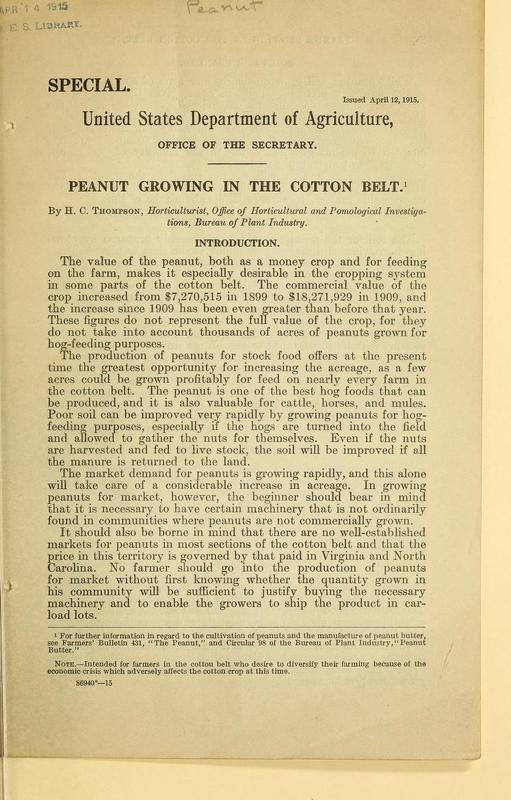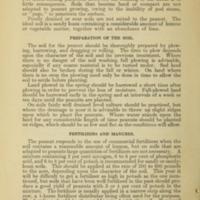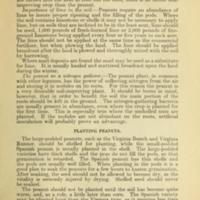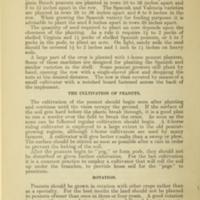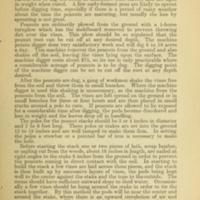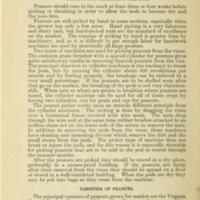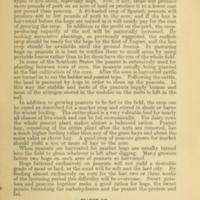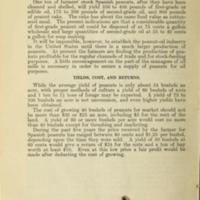Peanut Growing in the Cotton Belt
Creator
Date
1915
Excerpt
The value of the peanut, both as a money crop and for feeding on the farm, makes it especially desirable in the cropping system in some parts of the cotton belt. The commercial value of the crop increased from $7,270,515 in 1899 to $18,271,929 in 1909, and the increase since 1909 has been even greater than before that year. These figures do not represent the full value of the crop, for they do not take into account thousands of acres of peanuts grown for hog-feeding purposes.
The production of peanuts for stock food offers at the present time the greatest opportunity for increasing the acreage, as a few acres could be grown profitably for feed on nearly every farm in the cotton belt. The peanut is one of the best hog foods that can be produced, and it is also valuable for cattle, horses, and mules. Poor soil can be improved very rapidly by growing peanuts for hog-feeding purposes, especially if the hogs are turned into the field and allowed to gather the nuts for themselves. Even if the nuts are harvested and fed to live stock, the soil will be improved if all the manure is returned to the land.
The market demand for peanuts is growing rapidly, and this alone will take care of a considerable increase in acreage. In growing peanuts for market, however, the beginner should bear in mind that it is necessary to have certain machinery that is not ordinarily found in communities where peanuts are not commercially grown.
It should also be borne in mind that there are no well-established markets for peanuts in most sections of the cotton belt and that the price in this territory is governed by that paid in Virginia and North Carolina. No farmer should go into the production of peanuts for market without first knowing whether the quantity grown in his community will be sufficient to justify buying the necessary machinery and to enable the growers to ship the product in carload lots.
The production of peanuts for stock food offers at the present time the greatest opportunity for increasing the acreage, as a few acres could be grown profitably for feed on nearly every farm in the cotton belt. The peanut is one of the best hog foods that can be produced, and it is also valuable for cattle, horses, and mules. Poor soil can be improved very rapidly by growing peanuts for hog-feeding purposes, especially if the hogs are turned into the field and allowed to gather the nuts for themselves. Even if the nuts are harvested and fed to live stock, the soil will be improved if all the manure is returned to the land.
The market demand for peanuts is growing rapidly, and this alone will take care of a considerable increase in acreage. In growing peanuts for market, however, the beginner should bear in mind that it is necessary to have certain machinery that is not ordinarily found in communities where peanuts are not commercially grown.
It should also be borne in mind that there are no well-established markets for peanuts in most sections of the cotton belt and that the price in this territory is governed by that paid in Virginia and North Carolina. No farmer should go into the production of peanuts for market without first knowing whether the quantity grown in his community will be sufficient to justify buying the necessary machinery and to enable the growers to ship the product in carload lots.
Title
Peanut Growing in the Cotton Belt
File(s)
Peanut Growing in the Cotton Belt 1.jpg
(image/jpeg)
Peanut Growing in the Cotton Belt 2.jpg
(image/jpeg)
Peanut Growing in the Cotton Belt 3.jpg
(image/jpeg)
Peanut Growing in the Cotton Belt 4.jpg
(image/jpeg)
Peanut Growing in the Cotton Belt 5.jpg
(image/jpeg)
Peanut Growing in the Cotton Belt 6.jpg
(image/jpeg)
Peanut Growing in the Cotton Belt 7.jpg
(image/jpeg)
Peanut Growing in the Cotton Belt 8.jpg
(image/jpeg)
 An official website of the United States government.
An official website of the United States government.


